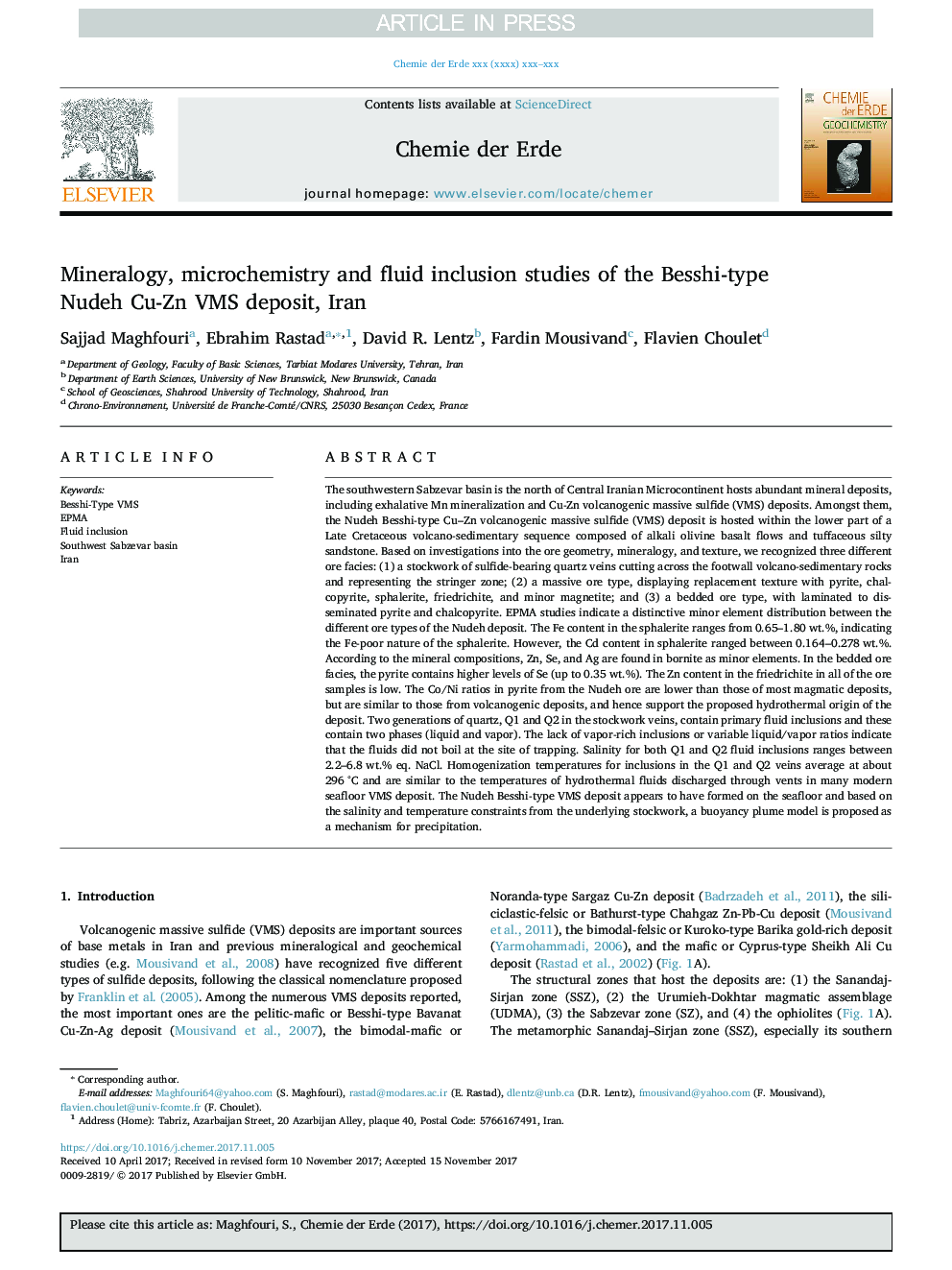| کد مقاله | کد نشریه | سال انتشار | مقاله انگلیسی | نسخه تمام متن |
|---|---|---|---|---|
| 8850184 | 1618707 | 2018 | 18 صفحه PDF | دانلود رایگان |
عنوان انگلیسی مقاله ISI
Mineralogy, microchemistry and fluid inclusion studies of the Besshi-type Nudeh Cu-Zn VMS deposit, Iran
دانلود مقاله + سفارش ترجمه
دانلود مقاله ISI انگلیسی
رایگان برای ایرانیان
کلمات کلیدی
موضوعات مرتبط
مهندسی و علوم پایه
علوم زمین و سیارات
ژئوشیمی و پترولوژی
پیش نمایش صفحه اول مقاله

چکیده انگلیسی
The southwestern Sabzevar basin is the north of Central Iranian Microcontinent hosts abundant mineral deposits, including exhalative Mn mineralization and Cu-Zn volcanogenic massive sulfide (VMS) deposits. Amongst them, the Nudeh Besshi-type Cu-Zn volcanogenic massive sulfide (VMS) deposit is hosted within the lower part of a Late Cretaceous volcano-sedimentary sequence composed of alkali olivine basalt flows and tuffaceous silty sandstone. Based on investigations into the ore geometry, mineralogy, and texture, we recognized three different ore facies: (1) a stockwork of sulfide-bearing quartz veins cutting across the footwall volcano-sedimentary rocks and representing the stringer zone; (2) a massive ore type, displaying replacement texture with pyrite, chalcopyrite, sphalerite, friedrichite, and minor magnetite; and (3) a bedded ore type, with laminated to disseminated pyrite and chalcopyrite. EPMA studies indicate a distinctive minor element distribution between the different ore types of the Nudeh deposit. The Fe content in the sphalerite ranges from 0.65-1.80â¯wt.%, indicating the Fe-poor nature of the sphalerite. However, the Cd content in sphalerite ranged between 0.164-0.278â¯wt.%. According to the mineral compositions, Zn, Se, and Ag are found in bornite as minor elements. In the bedded ore facies, the pyrite contains higher levels of Se (up to 0.35â¯wt.%). The Zn content in the friedrichite in all of the ore samples is low. The Co/Ni ratios in pyrite from the Nudeh ore are lower than those of most magmatic deposits, but are similar to those from volcanogenic deposits, and hence support the proposed hydrothermal origin of the deposit. Two generations of quartz, Q1 and Q2 in the stockwork veins, contain primary fluid inclusions and these contain two phases (liquid and vapor). The lack of vapor-rich inclusions or variable liquid/vapor ratios indicate that the fluids did not boil at the site of trapping. Salinity for both Q1 and Q2 fluid inclusions ranges between 2.2-6.8â¯wt.% eq. NaCl. Homogenization temperatures for inclusions in the Q1 and Q2 veins average at about 296â¯Â°C and are similar to the temperatures of hydrothermal fluids discharged through vents in many modern seafloor VMS deposit. The Nudeh Besshi-type VMS deposit appears to have formed on the seafloor and based on the salinity and temperature constraints from the underlying stockwork, a buoyancy plume model is proposed as a mechanism for precipitation.
ناشر
Database: Elsevier - ScienceDirect (ساینس دایرکت)
Journal: Chemie der Erde - Volume 78, Issue 1, April 2018, Pages 40-57
Journal: Chemie der Erde - Volume 78, Issue 1, April 2018, Pages 40-57
نویسندگان
Sajjad Maghfouri, Ebrahim Rastad, David R. Lentz, Fardin Mousivand, Flavien Choulet,